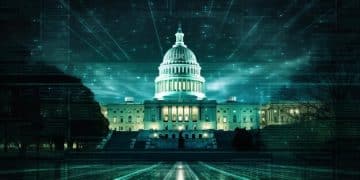US Treasury & DeFi in 2025: A Regulatory Outlook

Understanding the US Treasury’s Stance on Decentralized Finance (DeFi) in 2025 involves analyzing potential regulatory frameworks, enforcement priorities, and their impact on the innovation and adoption of cryptocurrency-based financial services within the United States.
Navigating the evolving landscape of decentralized finance (DeFi) requires a keen understanding of regulatory trends. This article explores Understanding the US Treasury’s Stance on Decentralized Finance (DeFi) in 2025, examining potential policy decisions and their implications for the future of crypto in the US.
The Rising Significance of DeFi in the US Financial Ecosystem
Decentralized Finance (DeFi) has rapidly emerged as a transformative force within the financial technology sector. Understanding its growth and potential impact is crucial for both innovators and regulators in the United States.
DeFi platforms offer a range of financial services, typically without traditional intermediaries like banks. This has the potential to democratize access to finance, but also raises concerns about consumer protection, security, and stability.
Key Features of DeFi
DeFi operates on blockchain technology, primarily Ethereum, and utilizes smart contracts to automate financial processes. Here’s a look at some core features:
- Decentralization: DeFi aims to reduce reliance on central authorities, distributing control among users and code.
- Composability: DeFi protocols can be built upon each other, creating interconnected financial applications.
- Transparency: Transactions and code are often publicly viewable on the blockchain, though privacy concerns remain.

The expansion of DeFi has prompted interest and concern from regulatory bodies globally, particularly in the United States. The potential for financial innovation is balanced against the need to mitigate risks and maintain market integrity.
Analyzing the US Treasury’s Current Position on DeFi
The US Treasury plays a vital role in shaping financial regulations. Understanding their current stance on DeFi is crucial for predicting future policy directions.
The Treasury Department is concerned with illicit finance risks, investor protection, and the potential impact of DeFi on the stability of the broader financial system.
Key Concerns Expressed by the Treasury
Several statements and reports from the Treasury highlight specific areas of focus regarding DeFi:
- Anti-Money Laundering (AML): Ensuring DeFi platforms comply with AML regulations to prevent illicit activities.
- Consumer Protection: Protecting investors from fraud, scams, and market manipulation in the DeFi space.
- Financial Stability: Monitoring the potential systemic risks posed by DeFi to the overall financial system.
The Treasury Department is actively engaging with industry stakeholders and international partners to develop a comprehensive understanding of the DeFi landscape and appropriate regulatory responses.
They are also emphasizing the need for collaboration between regulatory agencies, such as the SEC and CFTC, to ensure consistent and effective oversight of DeFi activities.
Potential Regulatory Pathways for DeFi in 2025
Looking ahead to 2025, several regulatory pathways for DeFi are plausible. These depend on how the industry evolves and how effectively regulators address the associated risks.
One potential scenario involves adapting existing regulatory frameworks to fit DeFi activities. Another involves creating new, bespoke regulations specifically tailored to the unique characteristics of DeFi.

Possible Regulatory Outcomes
- Increased Scrutiny: Expect more stringent KYC/AML requirements for DeFi platforms and participants.
- Regulatory Sandboxes: The creation of controlled environments for testing innovative DeFi products and services.
- Inter-Agency Coordination: Enhanced collaboration between the Treasury, SEC, CFTC, and other agencies to oversee DeFi activities.
- Stablecoin Regulation: Clear rules for stablecoin issuers to ensure reserves are adequate and prevent systemic risk.
The regulatory approach will likely aim to strike a balance between fostering innovation and mitigating risks. The outcome will largely depend on the ability of the DeFi industry to self-regulate and address regulatory concerns proactively.
Ultimately, effective regulation will be critical for the long-term success and mainstream adoption of DeFi in the United States.
Impact of US Treasury’s Stance on DeFi Innovation
The US Treasury’s stance on DeFi will significantly impact the pace and direction of innovation in the sector. Clear and balanced regulations can foster sustainable growth, while overly restrictive policies could stifle innovation.
If regulations are too burdensome, DeFi development could shift to jurisdictions with more favorable regulatory environments. This could put the US at a competitive disadvantage in the global financial technology landscape.
Potential Impacts on Innovation
Here are a few ways the Treasury’s stance could affect DeFi innovation:
The approach will influence the types of DeFi projects that are developed and the level of investment they attract.
- Focus on Compliance: Companies may prioritize compliance over pure innovation, leading to more compliant but potentially less cutting-edge solutions.
- Brain Drain: Talented developers and entrepreneurs may move to countries with more welcoming regulatory environments.
- Reduced Investment: Investors may become hesitant to invest in DeFi projects if the regulatory landscape is uncertain or overly restrictive.
Alternatively, a well-calibrated regulatory framework could provide the clarity and certainty needed to attract investment and encourage responsible innovation in the DeFi space.
The Treasury’s approach will play a crucial role in determining whether the US becomes a global leader or a laggard in the DeFi revolution.
Challenges and Opportunities for DeFi Compliance
Complying with potential US Treasury regulations presents both challenges and opportunities for DeFi platforms. Navigating this complex landscape requires a proactive and strategic approach.
One of the biggest challenges is adapting traditional compliance mechanisms to the decentralized nature of DeFi. This requires innovative solutions that can effectively address regulatory concerns without compromising the core principles of DeFi.
Key Challenges and Opportunities
Here’s a closer look at the challenges and opportunities for DeFi compliance:
- Data Privacy: Balancing the need for transparency with user privacy concerns.
- Smart Contract Audits: Ensuring smart contracts are secure and compliant through rigorous audits.
- International Standards: Aligning with global regulatory standards to facilitate cross-border DeFi activities.
Overcoming these challenges will require collaboration between DeFi platforms, regulators, and technology providers. By working together, they can create a compliance ecosystem that fosters innovation while safeguarding against risks.
Compliance can be a competitive advantage. Platforms that prioritize compliance are more likely to attract institutional investment and build trust with regulators and customers.
Forecasting the Future: DeFi’s Trajectory Under US Treasury Oversight
Predicting the future trajectory of DeFi under US Treasury oversight is challenging, but possible by assessing current trends and potential regulatory decisions. The landscape is likely to evolve significantly over the next few years.
One possible scenario is a gradual integration of DeFi into the traditional financial system, with increased regulatory oversight and adoption by mainstream institutions.
Future Scenarios for DeFi
The Treasury’s regulations is crucial to the future of the sector:
- Mainstream Adoption: Institutional investors and traditional financial firms begin actively participating in DeFi.
- Regulatory Clarity: Clear and consistent rules provide certainty for DeFi platforms and participants.
- Innovation Hubs: The US becomes a leading hub for DeFi innovation and development.
The future of DeFi under US Treasury oversight will depend on the ability of stakeholders to work together to create a regulatory framework that promotes innovation, protects consumers, and maintains financial stability. The next few years will be pivotal in shaping the long-term trajectory of DeFi in the United States.
Ultimately, the goal is to unlock the transformative potential of DeFi while mitigating the associated risks.
| Key Aspect | Brief Description |
|---|---|
| 🏛️ US Treasury’s Role | Shapes financial regulations impacting DeFi’s growth and stability. |
| 🛡️ Regulatory Concerns | Focus on AML, consumer protection, and financial system stability. |
| 🚀 Impact on Innovation | Balanced regulations foster innovation; strict rules may hinder growth. |
| 🤝 Compliance | Platforms must adapt to regulations while maintaining DeFi principles for success. |
Frequently Asked Questions (FAQ)
▼
DeFi refers to financial services built on blockchain technology, aiming to decentralize traditional financial systems. It utilizes smart contracts to automate processes like lending, borrowing, and trading without intermediaries.
▼
The US Treasury is primarily concerned about Anti-Money Laundering (AML), consumer protection, and the potential impact of DeFi on the stability of the broader financial system. They seek to mitigate these risks through regulation.
▼
Balanced regulations can foster innovation by providing clarity and certainty, while overly restrictive policies could stifle growth and drive development to other jurisdictions with more favorable environments.
▼
Challenges include adapting traditional compliance mechanisms to the decentralized nature of DeFi, ensuring data privacy, securing smart contracts, and aligning with international standards.
▼
The future may involve gradual integration of DeFi into the traditional financial system, with increased regulatory oversight and adoption by mainstream institutions. Regulatory clarity will be essential for US leadership in DeFi.
Conclusion
Understanding the US Treasury’s Stance on Decentralized Finance (DeFi) in 2025 requires ongoing monitoring of policy developments and a willingness to adapt to the evolving regulatory landscape. By fostering dialogue and collaboration, stakeholders can work together to unlock the transformative potential of DeFi while mitigating associated risks and ensuring a sustainable future for decentralized finance in the United States.





